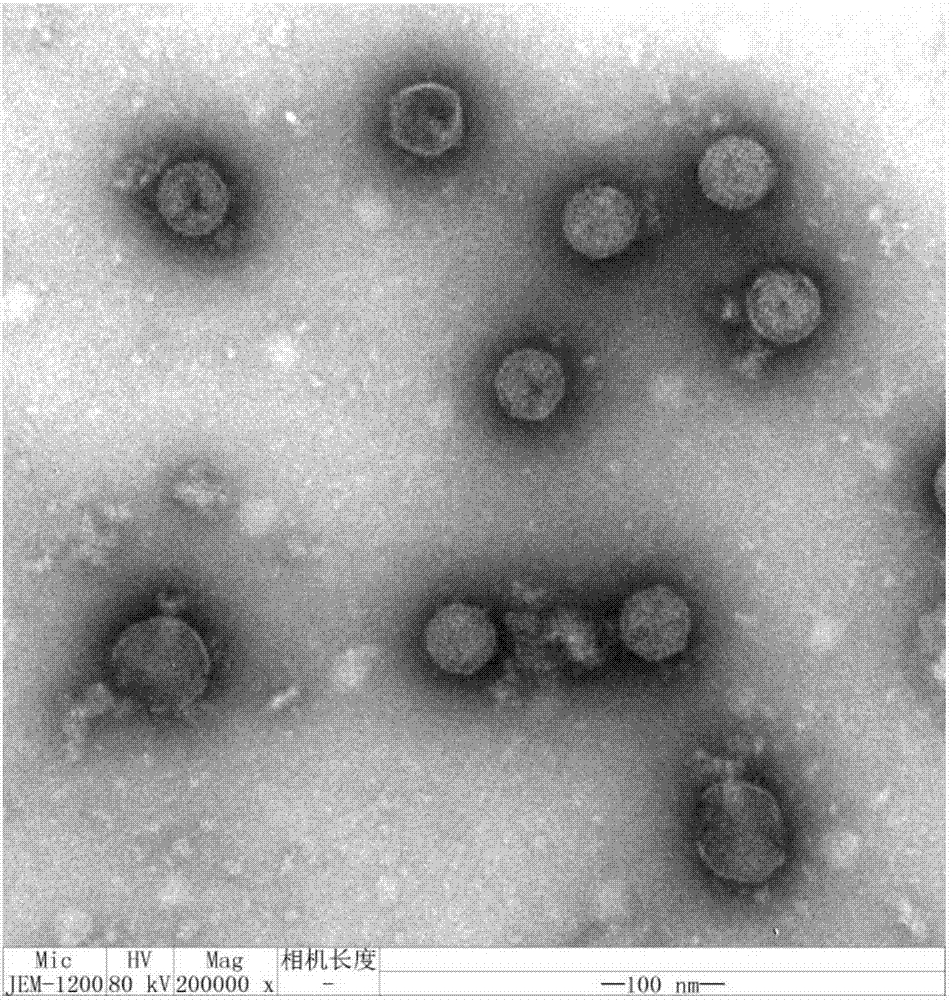Bacteriophage capable of controlling Salmonella typhimurium and application thereof
A technology of salmonella and phage, applied in the field of bioengineering, to achieve excellent acid resistance and heat resistance
- Summary
- Abstract
- Description
- Claims
- Application Information
AI Technical Summary
Problems solved by technology
Method used
Image
Examples
Embodiment 1
[0049] Example 1: Isolation and preparation of phage
[0050] The fecal liquid sewage sample among the present invention is collected from Shandong Province Tai'an City farmer's market;
[0051] The host bacteria was Salmonella typhimurium ATCC14028.
[0052] Fill 20mL Tris-HCl buffer solution into a 50mL centrifuge tube, then add a small amount of fecal sewage sample, and let it stand overnight at 4°C. The sample was centrifuged at 8000r / min for 10min to remove impurities, and the supernatant was centrifuged at 4000r / min for 10min and filtered with a 0.22μm microporous filter to obtain the filtrate and save it.
[0053] Take the above 20mL filtrate and add it to 20mL TSB medium, then add 1mL host bacterial suspension in the logarithmic growth phase, mix well and culture overnight at 37°C with shaking. The next day, centrifuge at 8000r / min for 30min, take 9mL of supernatant, add 10mL of TSB medium and 0.3mL of host bacterial suspension, place at room temperature for 1h, shak...
Embodiment 2
[0054] Embodiment 2: Amplification culture and purification of phage
[0055] Use the tip of a pipette to pick out the larger-diameter phage plaques, place them in the buffer, place them at 4°C for 3 hours, make a 10-fold gradient dilution with the buffer, and use the double-layer plate method for single-spot culture. Pick a single phage plaque with a larger diameter and place it in the host bacterial solution (the amount of bacteria is about 10 8 CFU / mL) in liquid TSB medium for 6 hours for a small amount of proliferation, and then observe the morphology of the plaques by the double-layer plate method. After repeating the operation 3 to 5 times, the plaques with the same shape and size can be obtained. Pick a single phage plaque and place it in buffer, transfer it into 3-5mL TSB medium, add 0.1mL of phage host bacterial solution, mix well, incubate at room temperature for 15min, incubate at 37°C for 10-14h, 12000rpm, Centrifuge at 4°C for 10 min, take the supernatant, and ad...
Embodiment 3
[0064] Embodiment 3: the influence of temperature and pH on phage stability
[0065] Take 0.5mL10 each 9 The phage liquid of PFU / mL was placed in a sterile EP tube, and reacted in a water bath at 30°C, 40°C, 50°C, 60°C, 70°C, 80°C, and 90°C for 60 minutes respectively. The samples were cooled in a water bath, and the titer of the phage was determined after dilution. see results image 3 , the titer of Salmonella typhimurium phage ΦSa-1 remained basically unchanged after being treated at 30°C, 40°C, 50°C, and 60°C for 1 hour, the titer decreased by an order of magnitude after being treated at 70°C for 1 hour, and the titer decreased after being treated at 80°C for 1 hour 2 orders of magnitude, all inactivated after treatment at 90°C for 1 hour.
[0066] Take a sterile EP tube and add 900 μL of liquid TSB with different pH values (1, 2, 3, 4, 5, 6, 7, 8, 9, 10, 11), and then place the above EP tube in a water bath at 37°C until After temperature equilibration, add 100 μL o...
PUM
| Property | Measurement | Unit |
|---|---|---|
| Diameter | aaaaa | aaaaa |
| Titer | aaaaa | aaaaa |
Abstract
Description
Claims
Application Information
 Login to View More
Login to View More - R&D
- Intellectual Property
- Life Sciences
- Materials
- Tech Scout
- Unparalleled Data Quality
- Higher Quality Content
- 60% Fewer Hallucinations
Browse by: Latest US Patents, China's latest patents, Technical Efficacy Thesaurus, Application Domain, Technology Topic, Popular Technical Reports.
© 2025 PatSnap. All rights reserved.Legal|Privacy policy|Modern Slavery Act Transparency Statement|Sitemap|About US| Contact US: help@patsnap.com



